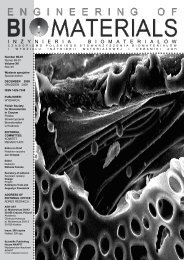88 - Polskie Stowarzyszenie BiomateriaÅów
88 - Polskie Stowarzyszenie BiomateriaÅów
88 - Polskie Stowarzyszenie BiomateriaÅów
You also want an ePaper? Increase the reach of your titles
YUMPU automatically turns print PDFs into web optimized ePapers that Google loves.
The characteristic bands of PLA located at 1745 cm -1 are<br />
corresponding to the C=O stretching vibrations. The bands<br />
at 1050-1250 cm -1 were related to the C-O, C-O-C stretching<br />
vibrations. Three bands in the range of 1300-1500 cm -1<br />
were attributed to symmetric and asymmetric deformational<br />
vibrations of C-H in CH 3 groups. Bands characteristic for<br />
HAp powder corresponding to the stretching vibrations of<br />
PO 4<br />
3-<br />
(956; 1047; 1099 cm -1 ) and deformation vibrations of<br />
PO 4<br />
3-<br />
(563; 605 cm -1 ) are presented in fig. 5 (1). Comparing<br />
the PLA/n-HAp spectra before and after immersion in SBF,<br />
some differences related to the presence of PO 4<br />
3-<br />
groups in<br />
the spectra of composite fibers after 14 days of immersion<br />
in SBF could be observed.<br />
FIG. 3. XRD pattern of HAp powder.<br />
Discussions<br />
In this work the morphological evolution of surfaces of<br />
composite fibers consisting of a PLA matrix filled with HAp<br />
subjected to the in vitro simulated physiological conditions<br />
was studied. In general, the results obtained in this study<br />
indicated that incorporation of the HAp particles in the polymer<br />
induced interesting changes in the surface morphology<br />
of the material. SEM observations revealed the formation<br />
of calcium phosphate (CaP) precipitates on the composite<br />
fibers surface. Already after 3 days the fibers surface was<br />
partially covered by the CaP formation. XRD and FTIR<br />
analysis confirmed presence of the apatite on the fibers<br />
surface after immersion in simulated body fluid.<br />
Conclusions<br />
Fig. 4. XRD patterns PLA/n-HAp samples after different<br />
time of immersion in SBF solution.<br />
Tests performed in SBF proved bioactivity of PLA/n-HAp<br />
fibers. The proposed method of production of PLA fibres<br />
described above allowed to obtain new composite fibers<br />
with desired bioactive properties. These fibers can then be<br />
easily transformed - by mechanical needle punching - into<br />
three dimensional porous structure, which may be potentially<br />
useful in tissue engineering applications, particularly as<br />
three-dimensional substrates for bone growth.<br />
Acknowledgments<br />
The authors would like to thank Mrs. S. Morcinek for her<br />
help in samples preparation. This work was supported by<br />
the Minister of Science and Higher Education; project POL–<br />
POSTDOK III no. PBZ/MNiSW/07/2006/53 (2007-2010).<br />
Fig. 5. FTIR spectra of HAp powder (1) as well as<br />
PLA/n-HAp fibers before (2) and after (3) immersion<br />
in SBF solution.<br />
The XRD pattern of HAp powder (fig. 3) exhibit diffraction<br />
maxima characteristic of the hydroxyapatite. The diffraction<br />
maxima of HAp clearly seen in HAp powder were not<br />
evident in the WAXS patterns of PLA/n-HAp sample before<br />
immersion in SBF solution (fig. 4) so that the presence of<br />
HAp in the structure at this stage could not be unequivocally<br />
confirmed using this method, as the quantity of additive was<br />
probably too low.<br />
The content of apatite in the PLA/n-HAp samples increases<br />
markedly during incubation time (fig. 4). In particular, the<br />
intensive diffraction maximum at 31.8 o corresponding to the<br />
hydroxyapatite (211) lattice plane appears clearly, which is<br />
a strong evidence of apatite growth on the surface of PLA/<br />
n-HAp samples after 7 and 14 days of immersion in SBF.<br />
The FTIR spectra of PLA/n-HAp fibers before and<br />
after immersion in SBF solution are shown in fig. 5.<br />
References<br />
[1] Yuan X et al. Characterization of poly (L-lactic acid) fibers<br />
produced by melt spinning. Journal of Applied Polymer Science<br />
2001; 81, 251-60.<br />
[2] F. Barre`re et al. Advanced biomaterials for skeletal tissue regeneration:<br />
Instructive and smart functions. Materials Science and<br />
Engineering 2008; R 59: 38–71.<br />
[3] Gupta B, Revagade N, Hiborn J. Poly(lactic acid) fiber: An overview.<br />
Progress in Polymer Science 2007; 32: 455-482.<br />
[4] M.Navarro et al. In vitro degradation behavior of a novel bioresorbable<br />
composite material based on PLA and soluble CaP glass.<br />
Acta Biomaterialia 2005; 1: 411-419.<br />
[5] Jose MV et al. Aligned PLGA/HA nanofibrous nanocomposite scaffolds<br />
for bone tissue engineering. Acta Biomaterialia 2009; 5: 305-315.<br />
[6] Kalita S.J. et al. Nanocrystalline calcium phosphate ceramics in<br />
biomedical engineering. Materials Science and Engineering 2007;<br />
C 27: 441–449.<br />
[7] Kasuga T et al. Preparation of poly(lactic acid) composites<br />
containing calcium carbonate (vaterite). Biomaterials 2003; 24:<br />
3247-3253.<br />
[8] Kokubo T et al. How useful is SBF in predicting in vivo bone<br />
bioactivity? Biomaterials 2006; 27 (15): 2907-2915.













